Article Review: Psychology of Social Class, Adolescents, and Beliefs
VerifiedAdded on 2021/05/30
|21
|6011
|27
Report
AI Summary
This report provides a comprehensive review of four articles published in the British Journal of Social Psychology, the British Journal of Educational Psychology, and the British Journal of Developmental Psychology. The first article examines the psychology of social class, exploring how socioeconomic status influences thought, feelings, and behavior, and how individuals perceive their place in society. The second article investigates agency and responsibility in adolescent students, focusing on the impact of good experiences in school on academic achievement and positive career resolutions, and it examines the student's role in their own development. The third article delves into profiling children's emotion regulation behaviors, defining different patterns of emotional responses in children aged 6-12 years. Finally, the fourth article discusses how children and adults conceive of different agents' moral beliefs, specifically comparing their own beliefs with those of other people and God, focusing on the development of moral understanding.

Running Head: Article Review 1
Article Review
Student Name
University
Article Review
Student Name
University
Paraphrase This Document
Need a fresh take? Get an instant paraphrase of this document with our AI Paraphraser
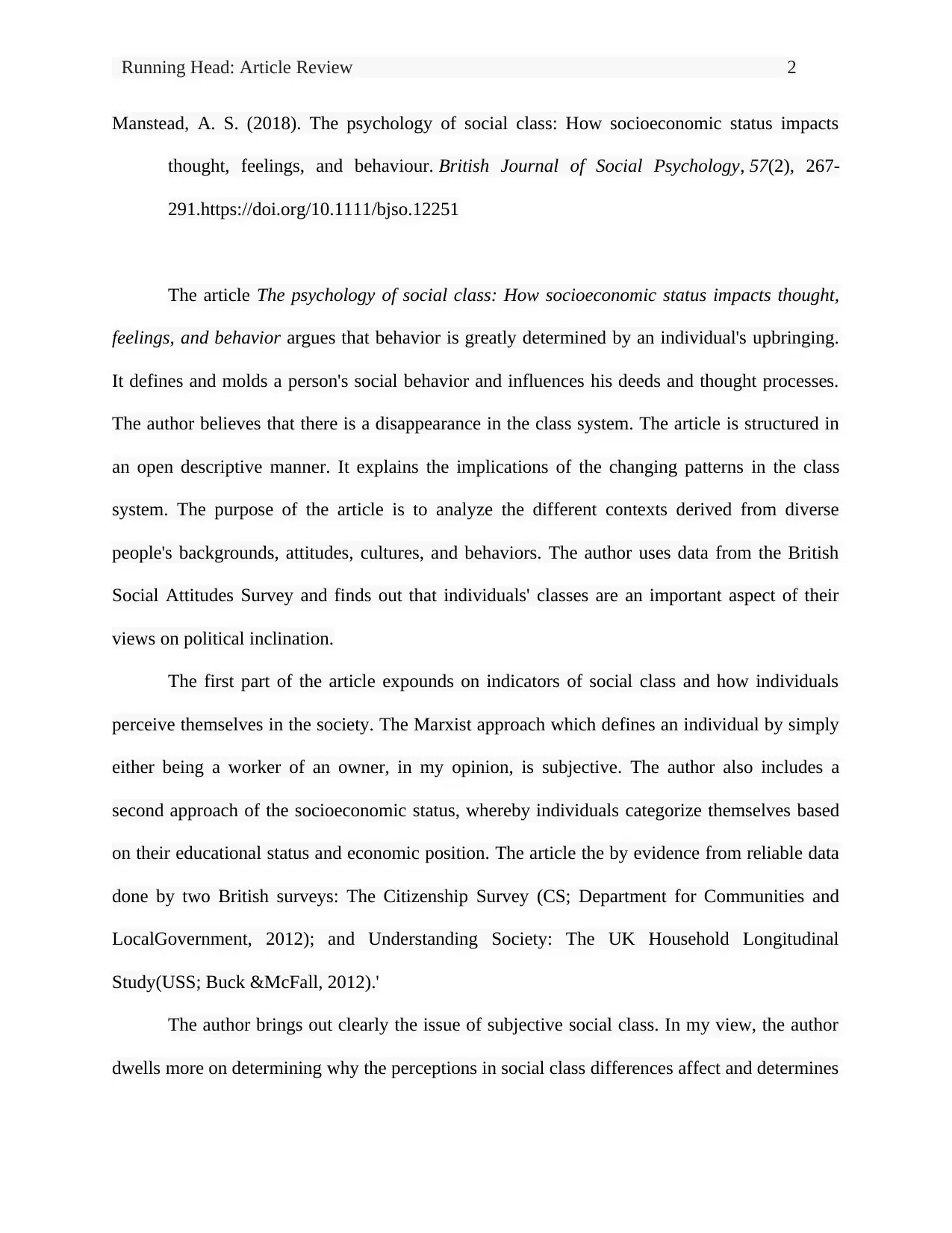
Running Head: Article Review 2
Manstead, A. S. (2018). The psychology of social class: How socioeconomic status impacts
thought, feelings, and behaviour. British Journal of Social Psychology, 57(2), 267-
291.https://doi.org/10.1111/bjso.12251
The article The psychology of social class: How socioeconomic status impacts thought,
feelings, and behavior argues that behavior is greatly determined by an individual's upbringing.
It defines and molds a person's social behavior and influences his deeds and thought processes.
The author believes that there is a disappearance in the class system. The article is structured in
an open descriptive manner. It explains the implications of the changing patterns in the class
system. The purpose of the article is to analyze the different contexts derived from diverse
people's backgrounds, attitudes, cultures, and behaviors. The author uses data from the British
Social Attitudes Survey and finds out that individuals' classes are an important aspect of their
views on political inclination.
The first part of the article expounds on indicators of social class and how individuals
perceive themselves in the society. The Marxist approach which defines an individual by simply
either being a worker of an owner, in my opinion, is subjective. The author also includes a
second approach of the socioeconomic status, whereby individuals categorize themselves based
on their educational status and economic position. The article the by evidence from reliable data
done by two British surveys: The Citizenship Survey (CS; Department for Communities and
LocalGovernment, 2012); and Understanding Society: The UK Household Longitudinal
Study(USS; Buck &McFall, 2012).'
The author brings out clearly the issue of subjective social class. In my view, the author
dwells more on determining why the perceptions in social class differences affect and determines
Manstead, A. S. (2018). The psychology of social class: How socioeconomic status impacts
thought, feelings, and behaviour. British Journal of Social Psychology, 57(2), 267-
291.https://doi.org/10.1111/bjso.12251
The article The psychology of social class: How socioeconomic status impacts thought,
feelings, and behavior argues that behavior is greatly determined by an individual's upbringing.
It defines and molds a person's social behavior and influences his deeds and thought processes.
The author believes that there is a disappearance in the class system. The article is structured in
an open descriptive manner. It explains the implications of the changing patterns in the class
system. The purpose of the article is to analyze the different contexts derived from diverse
people's backgrounds, attitudes, cultures, and behaviors. The author uses data from the British
Social Attitudes Survey and finds out that individuals' classes are an important aspect of their
views on political inclination.
The first part of the article expounds on indicators of social class and how individuals
perceive themselves in the society. The Marxist approach which defines an individual by simply
either being a worker of an owner, in my opinion, is subjective. The author also includes a
second approach of the socioeconomic status, whereby individuals categorize themselves based
on their educational status and economic position. The article the by evidence from reliable data
done by two British surveys: The Citizenship Survey (CS; Department for Communities and
LocalGovernment, 2012); and Understanding Society: The UK Household Longitudinal
Study(USS; Buck &McFall, 2012).'
The author brings out clearly the issue of subjective social class. In my view, the author
dwells more on determining why the perceptions in social class differences affect and determines
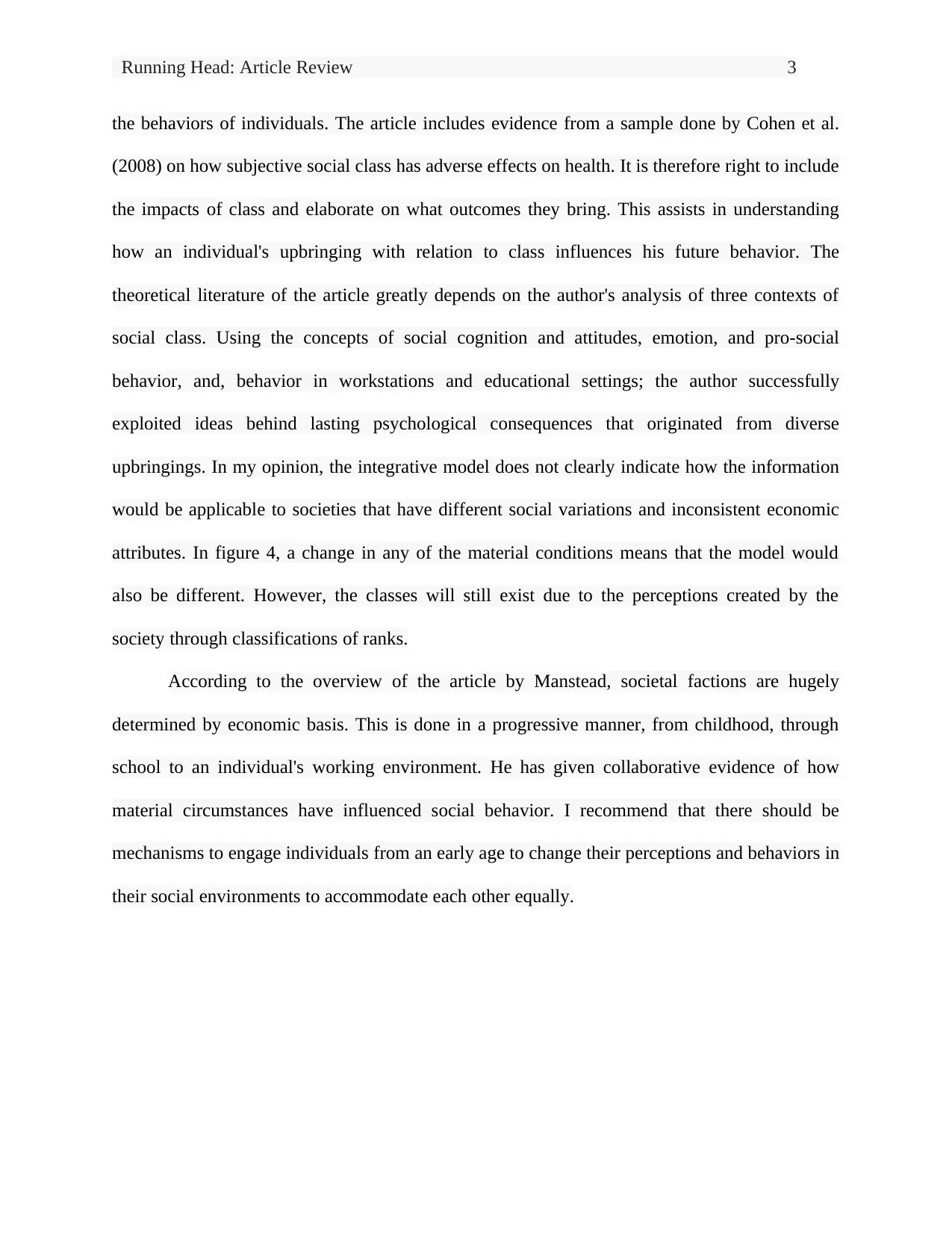
Running Head: Article Review 3
the behaviors of individuals. The article includes evidence from a sample done by Cohen et al.
(2008) on how subjective social class has adverse effects on health. It is therefore right to include
the impacts of class and elaborate on what outcomes they bring. This assists in understanding
how an individual's upbringing with relation to class influences his future behavior. The
theoretical literature of the article greatly depends on the author's analysis of three contexts of
social class. Using the concepts of social cognition and attitudes, emotion, and pro-social
behavior, and, behavior in workstations and educational settings; the author successfully
exploited ideas behind lasting psychological consequences that originated from diverse
upbringings. In my opinion, the integrative model does not clearly indicate how the information
would be applicable to societies that have different social variations and inconsistent economic
attributes. In figure 4, a change in any of the material conditions means that the model would
also be different. However, the classes will still exist due to the perceptions created by the
society through classifications of ranks.
According to the overview of the article by Manstead, societal factions are hugely
determined by economic basis. This is done in a progressive manner, from childhood, through
school to an individual's working environment. He has given collaborative evidence of how
material circumstances have influenced social behavior. I recommend that there should be
mechanisms to engage individuals from an early age to change their perceptions and behaviors in
their social environments to accommodate each other equally.
the behaviors of individuals. The article includes evidence from a sample done by Cohen et al.
(2008) on how subjective social class has adverse effects on health. It is therefore right to include
the impacts of class and elaborate on what outcomes they bring. This assists in understanding
how an individual's upbringing with relation to class influences his future behavior. The
theoretical literature of the article greatly depends on the author's analysis of three contexts of
social class. Using the concepts of social cognition and attitudes, emotion, and pro-social
behavior, and, behavior in workstations and educational settings; the author successfully
exploited ideas behind lasting psychological consequences that originated from diverse
upbringings. In my opinion, the integrative model does not clearly indicate how the information
would be applicable to societies that have different social variations and inconsistent economic
attributes. In figure 4, a change in any of the material conditions means that the model would
also be different. However, the classes will still exist due to the perceptions created by the
society through classifications of ranks.
According to the overview of the article by Manstead, societal factions are hugely
determined by economic basis. This is done in a progressive manner, from childhood, through
school to an individual's working environment. He has given collaborative evidence of how
material circumstances have influenced social behavior. I recommend that there should be
mechanisms to engage individuals from an early age to change their perceptions and behaviors in
their social environments to accommodate each other equally.
⊘ This is a preview!⊘
Do you want full access?
Subscribe today to unlock all pages.

Trusted by 1+ million students worldwide
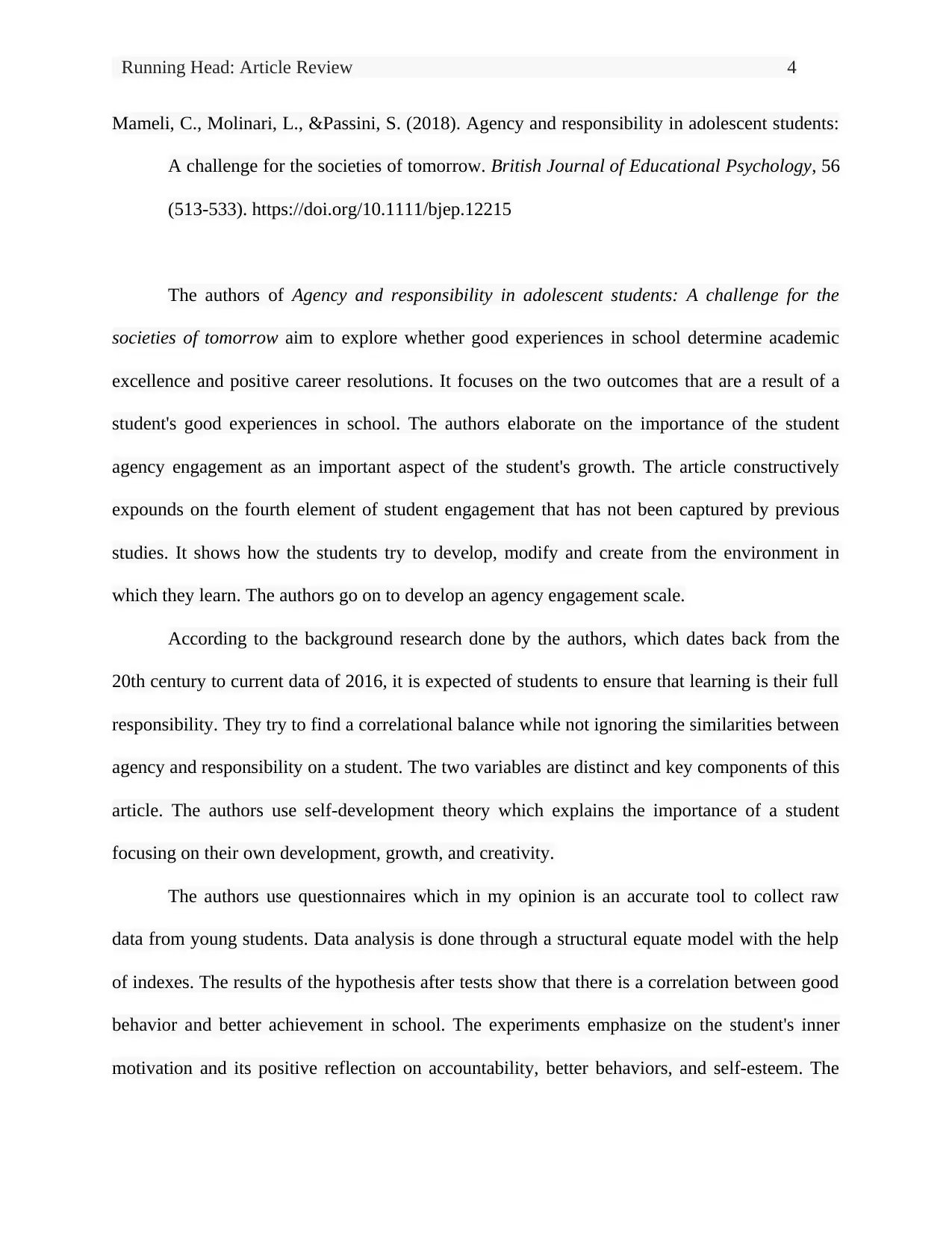
Running Head: Article Review 4
Mameli, C., Molinari, L., &Passini, S. (2018). Agency and responsibility in adolescent students:
A challenge for the societies of tomorrow. British Journal of Educational Psychology, 56
(513-533). https://doi.org/10.1111/bjep.12215
The authors of Agency and responsibility in adolescent students: A challenge for the
societies of tomorrow aim to explore whether good experiences in school determine academic
excellence and positive career resolutions. It focuses on the two outcomes that are a result of a
student's good experiences in school. The authors elaborate on the importance of the student
agency engagement as an important aspect of the student's growth. The article constructively
expounds on the fourth element of student engagement that has not been captured by previous
studies. It shows how the students try to develop, modify and create from the environment in
which they learn. The authors go on to develop an agency engagement scale.
According to the background research done by the authors, which dates back from the
20th century to current data of 2016, it is expected of students to ensure that learning is their full
responsibility. They try to find a correlational balance while not ignoring the similarities between
agency and responsibility on a student. The two variables are distinct and key components of this
article. The authors use self-development theory which explains the importance of a student
focusing on their own development, growth, and creativity.
The authors use questionnaires which in my opinion is an accurate tool to collect raw
data from young students. Data analysis is done through a structural equate model with the help
of indexes. The results of the hypothesis after tests show that there is a correlation between good
behavior and better achievement in school. The experiments emphasize on the student's inner
motivation and its positive reflection on accountability, better behaviors, and self-esteem. The
Mameli, C., Molinari, L., &Passini, S. (2018). Agency and responsibility in adolescent students:
A challenge for the societies of tomorrow. British Journal of Educational Psychology, 56
(513-533). https://doi.org/10.1111/bjep.12215
The authors of Agency and responsibility in adolescent students: A challenge for the
societies of tomorrow aim to explore whether good experiences in school determine academic
excellence and positive career resolutions. It focuses on the two outcomes that are a result of a
student's good experiences in school. The authors elaborate on the importance of the student
agency engagement as an important aspect of the student's growth. The article constructively
expounds on the fourth element of student engagement that has not been captured by previous
studies. It shows how the students try to develop, modify and create from the environment in
which they learn. The authors go on to develop an agency engagement scale.
According to the background research done by the authors, which dates back from the
20th century to current data of 2016, it is expected of students to ensure that learning is their full
responsibility. They try to find a correlational balance while not ignoring the similarities between
agency and responsibility on a student. The two variables are distinct and key components of this
article. The authors use self-development theory which explains the importance of a student
focusing on their own development, growth, and creativity.
The authors use questionnaires which in my opinion is an accurate tool to collect raw
data from young students. Data analysis is done through a structural equate model with the help
of indexes. The results of the hypothesis after tests show that there is a correlation between good
behavior and better achievement in school. The experiments emphasize on the student's inner
motivation and its positive reflection on accountability, better behaviors, and self-esteem. The
Paraphrase This Document
Need a fresh take? Get an instant paraphrase of this document with our AI Paraphraser
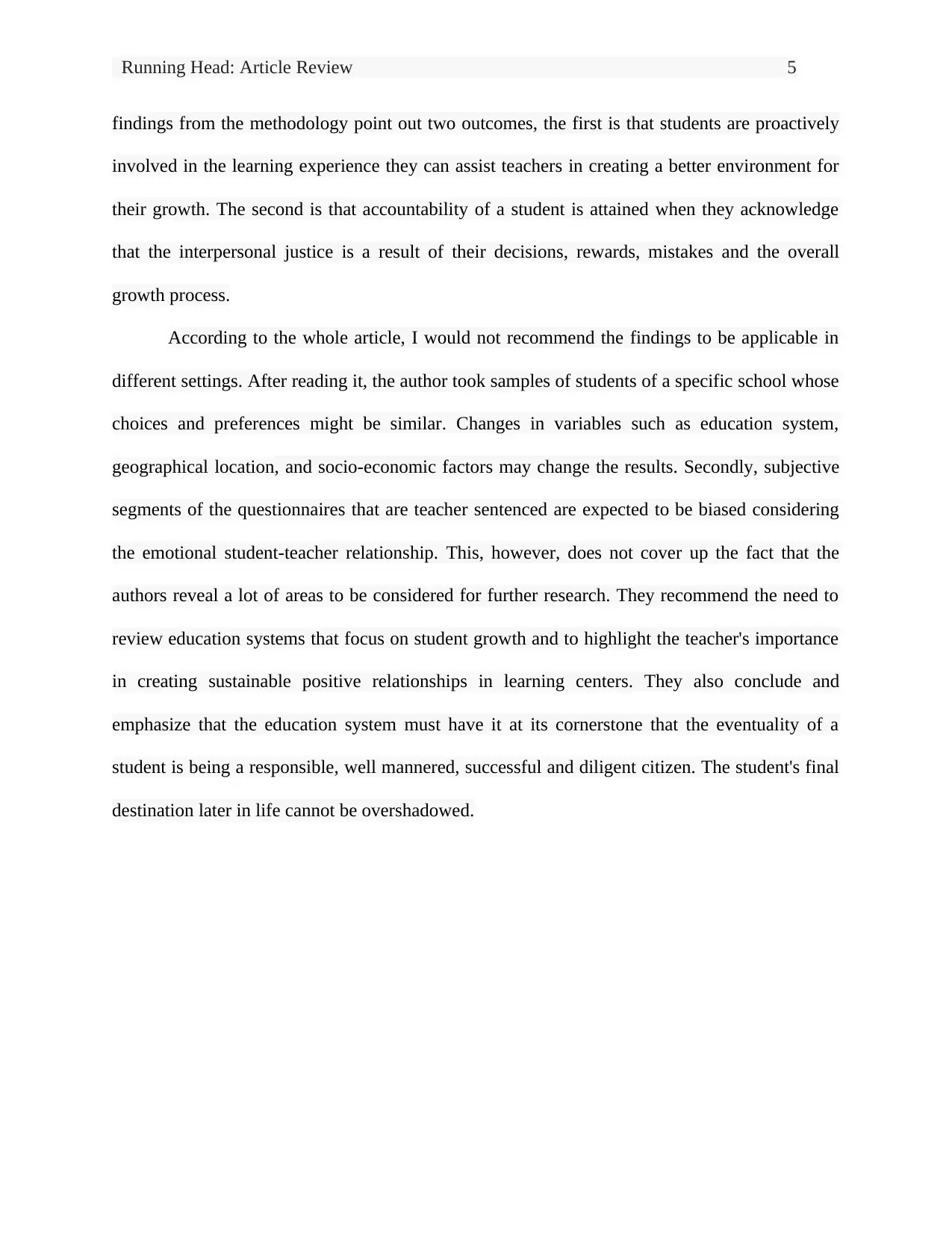
Running Head: Article Review 5
findings from the methodology point out two outcomes, the first is that students are proactively
involved in the learning experience they can assist teachers in creating a better environment for
their growth. The second is that accountability of a student is attained when they acknowledge
that the interpersonal justice is a result of their decisions, rewards, mistakes and the overall
growth process.
According to the whole article, I would not recommend the findings to be applicable in
different settings. After reading it, the author took samples of students of a specific school whose
choices and preferences might be similar. Changes in variables such as education system,
geographical location, and socio-economic factors may change the results. Secondly, subjective
segments of the questionnaires that are teacher sentenced are expected to be biased considering
the emotional student-teacher relationship. This, however, does not cover up the fact that the
authors reveal a lot of areas to be considered for further research. They recommend the need to
review education systems that focus on student growth and to highlight the teacher's importance
in creating sustainable positive relationships in learning centers. They also conclude and
emphasize that the education system must have it at its cornerstone that the eventuality of a
student is being a responsible, well mannered, successful and diligent citizen. The student's final
destination later in life cannot be overshadowed.
findings from the methodology point out two outcomes, the first is that students are proactively
involved in the learning experience they can assist teachers in creating a better environment for
their growth. The second is that accountability of a student is attained when they acknowledge
that the interpersonal justice is a result of their decisions, rewards, mistakes and the overall
growth process.
According to the whole article, I would not recommend the findings to be applicable in
different settings. After reading it, the author took samples of students of a specific school whose
choices and preferences might be similar. Changes in variables such as education system,
geographical location, and socio-economic factors may change the results. Secondly, subjective
segments of the questionnaires that are teacher sentenced are expected to be biased considering
the emotional student-teacher relationship. This, however, does not cover up the fact that the
authors reveal a lot of areas to be considered for further research. They recommend the need to
review education systems that focus on student growth and to highlight the teacher's importance
in creating sustainable positive relationships in learning centers. They also conclude and
emphasize that the education system must have it at its cornerstone that the eventuality of a
student is being a responsible, well mannered, successful and diligent citizen. The student's final
destination later in life cannot be overshadowed.
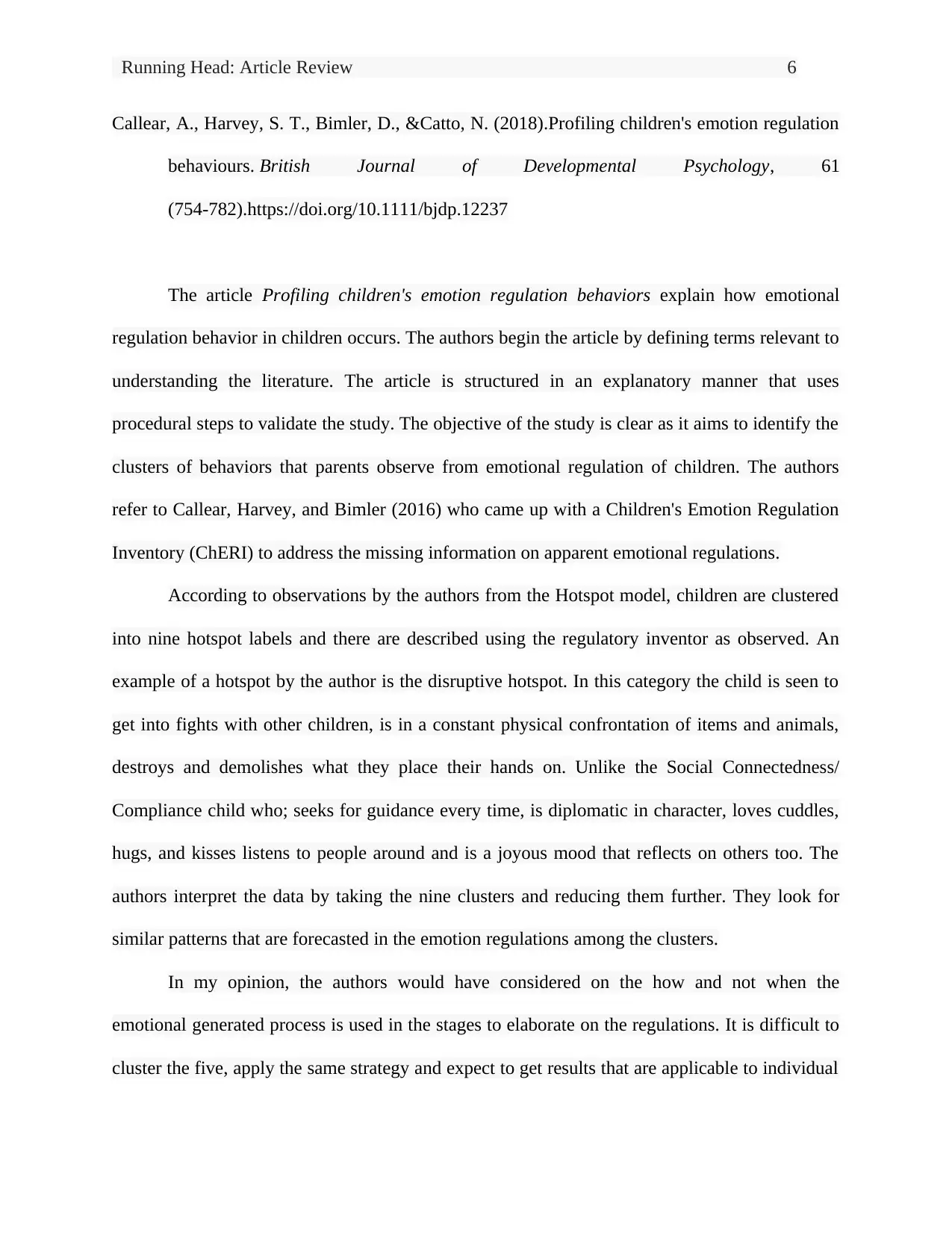
Running Head: Article Review 6
Callear, A., Harvey, S. T., Bimler, D., &Catto, N. (2018).Profiling children's emotion regulation
behaviours. British Journal of Developmental Psychology, 61
(754-782).https://doi.org/10.1111/bjdp.12237
The article Profiling children's emotion regulation behaviors explain how emotional
regulation behavior in children occurs. The authors begin the article by defining terms relevant to
understanding the literature. The article is structured in an explanatory manner that uses
procedural steps to validate the study. The objective of the study is clear as it aims to identify the
clusters of behaviors that parents observe from emotional regulation of children. The authors
refer to Callear, Harvey, and Bimler (2016) who came up with a Children's Emotion Regulation
Inventory (ChERI) to address the missing information on apparent emotional regulations.
According to observations by the authors from the Hotspot model, children are clustered
into nine hotspot labels and there are described using the regulatory inventor as observed. An
example of a hotspot by the author is the disruptive hotspot. In this category the child is seen to
get into fights with other children, is in a constant physical confrontation of items and animals,
destroys and demolishes what they place their hands on. Unlike the Social Connectedness/
Compliance child who; seeks for guidance every time, is diplomatic in character, loves cuddles,
hugs, and kisses listens to people around and is a joyous mood that reflects on others too. The
authors interpret the data by taking the nine clusters and reducing them further. They look for
similar patterns that are forecasted in the emotion regulations among the clusters.
In my opinion, the authors would have considered on the how and not when the
emotional generated process is used in the stages to elaborate on the regulations. It is difficult to
cluster the five, apply the same strategy and expect to get results that are applicable to individual
Callear, A., Harvey, S. T., Bimler, D., &Catto, N. (2018).Profiling children's emotion regulation
behaviours. British Journal of Developmental Psychology, 61
(754-782).https://doi.org/10.1111/bjdp.12237
The article Profiling children's emotion regulation behaviors explain how emotional
regulation behavior in children occurs. The authors begin the article by defining terms relevant to
understanding the literature. The article is structured in an explanatory manner that uses
procedural steps to validate the study. The objective of the study is clear as it aims to identify the
clusters of behaviors that parents observe from emotional regulation of children. The authors
refer to Callear, Harvey, and Bimler (2016) who came up with a Children's Emotion Regulation
Inventory (ChERI) to address the missing information on apparent emotional regulations.
According to observations by the authors from the Hotspot model, children are clustered
into nine hotspot labels and there are described using the regulatory inventor as observed. An
example of a hotspot by the author is the disruptive hotspot. In this category the child is seen to
get into fights with other children, is in a constant physical confrontation of items and animals,
destroys and demolishes what they place their hands on. Unlike the Social Connectedness/
Compliance child who; seeks for guidance every time, is diplomatic in character, loves cuddles,
hugs, and kisses listens to people around and is a joyous mood that reflects on others too. The
authors interpret the data by taking the nine clusters and reducing them further. They look for
similar patterns that are forecasted in the emotion regulations among the clusters.
In my opinion, the authors would have considered on the how and not when the
emotional generated process is used in the stages to elaborate on the regulations. It is difficult to
cluster the five, apply the same strategy and expect to get results that are applicable to individual
⊘ This is a preview!⊘
Do you want full access?
Subscribe today to unlock all pages.

Trusted by 1+ million students worldwide
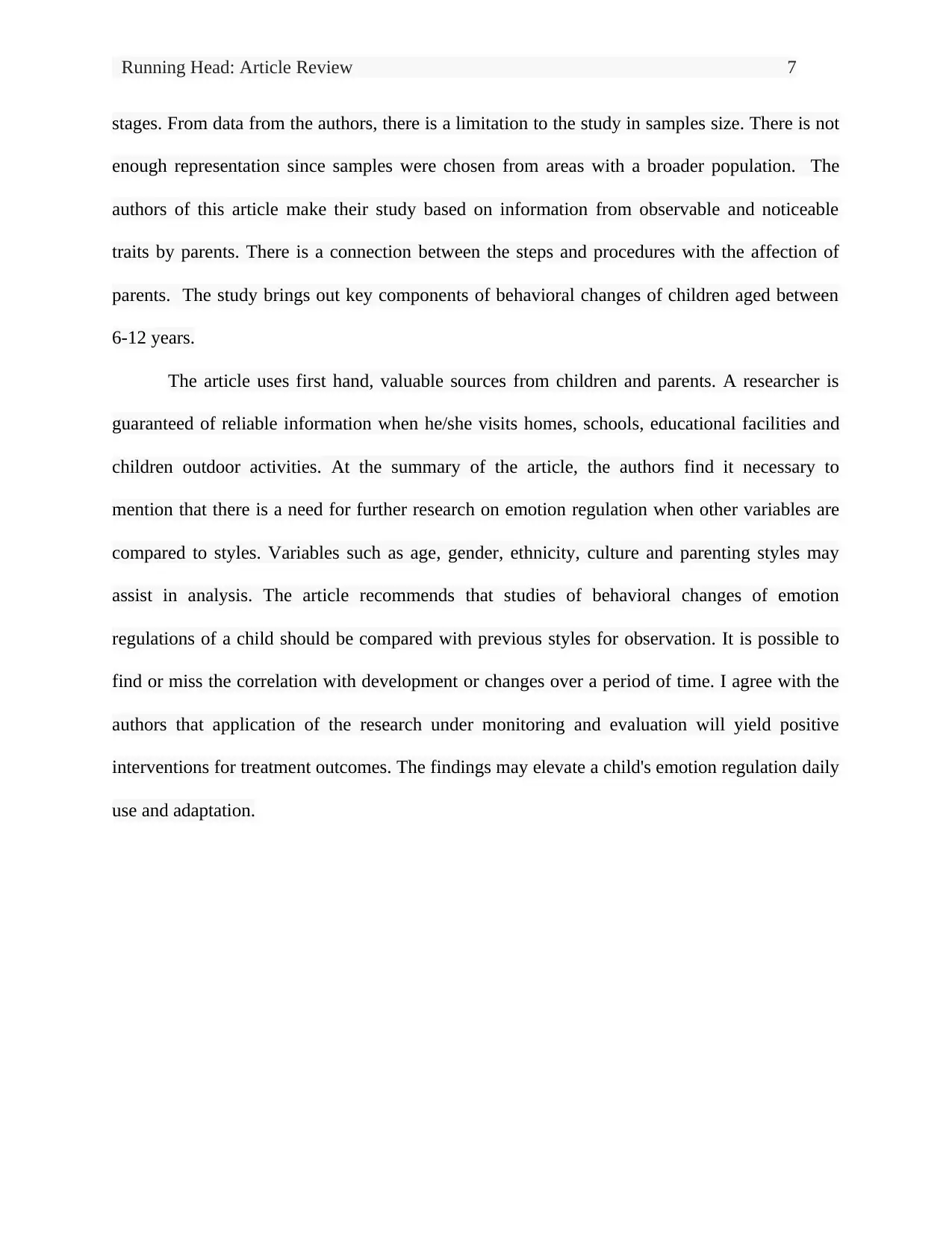
Running Head: Article Review 7
stages. From data from the authors, there is a limitation to the study in samples size. There is not
enough representation since samples were chosen from areas with a broader population. The
authors of this article make their study based on information from observable and noticeable
traits by parents. There is a connection between the steps and procedures with the affection of
parents. The study brings out key components of behavioral changes of children aged between
6-12 years.
The article uses first hand, valuable sources from children and parents. A researcher is
guaranteed of reliable information when he/she visits homes, schools, educational facilities and
children outdoor activities. At the summary of the article, the authors find it necessary to
mention that there is a need for further research on emotion regulation when other variables are
compared to styles. Variables such as age, gender, ethnicity, culture and parenting styles may
assist in analysis. The article recommends that studies of behavioral changes of emotion
regulations of a child should be compared with previous styles for observation. It is possible to
find or miss the correlation with development or changes over a period of time. I agree with the
authors that application of the research under monitoring and evaluation will yield positive
interventions for treatment outcomes. The findings may elevate a child's emotion regulation daily
use and adaptation.
stages. From data from the authors, there is a limitation to the study in samples size. There is not
enough representation since samples were chosen from areas with a broader population. The
authors of this article make their study based on information from observable and noticeable
traits by parents. There is a connection between the steps and procedures with the affection of
parents. The study brings out key components of behavioral changes of children aged between
6-12 years.
The article uses first hand, valuable sources from children and parents. A researcher is
guaranteed of reliable information when he/she visits homes, schools, educational facilities and
children outdoor activities. At the summary of the article, the authors find it necessary to
mention that there is a need for further research on emotion regulation when other variables are
compared to styles. Variables such as age, gender, ethnicity, culture and parenting styles may
assist in analysis. The article recommends that studies of behavioral changes of emotion
regulations of a child should be compared with previous styles for observation. It is possible to
find or miss the correlation with development or changes over a period of time. I agree with the
authors that application of the research under monitoring and evaluation will yield positive
interventions for treatment outcomes. The findings may elevate a child's emotion regulation daily
use and adaptation.
Paraphrase This Document
Need a fresh take? Get an instant paraphrase of this document with our AI Paraphraser
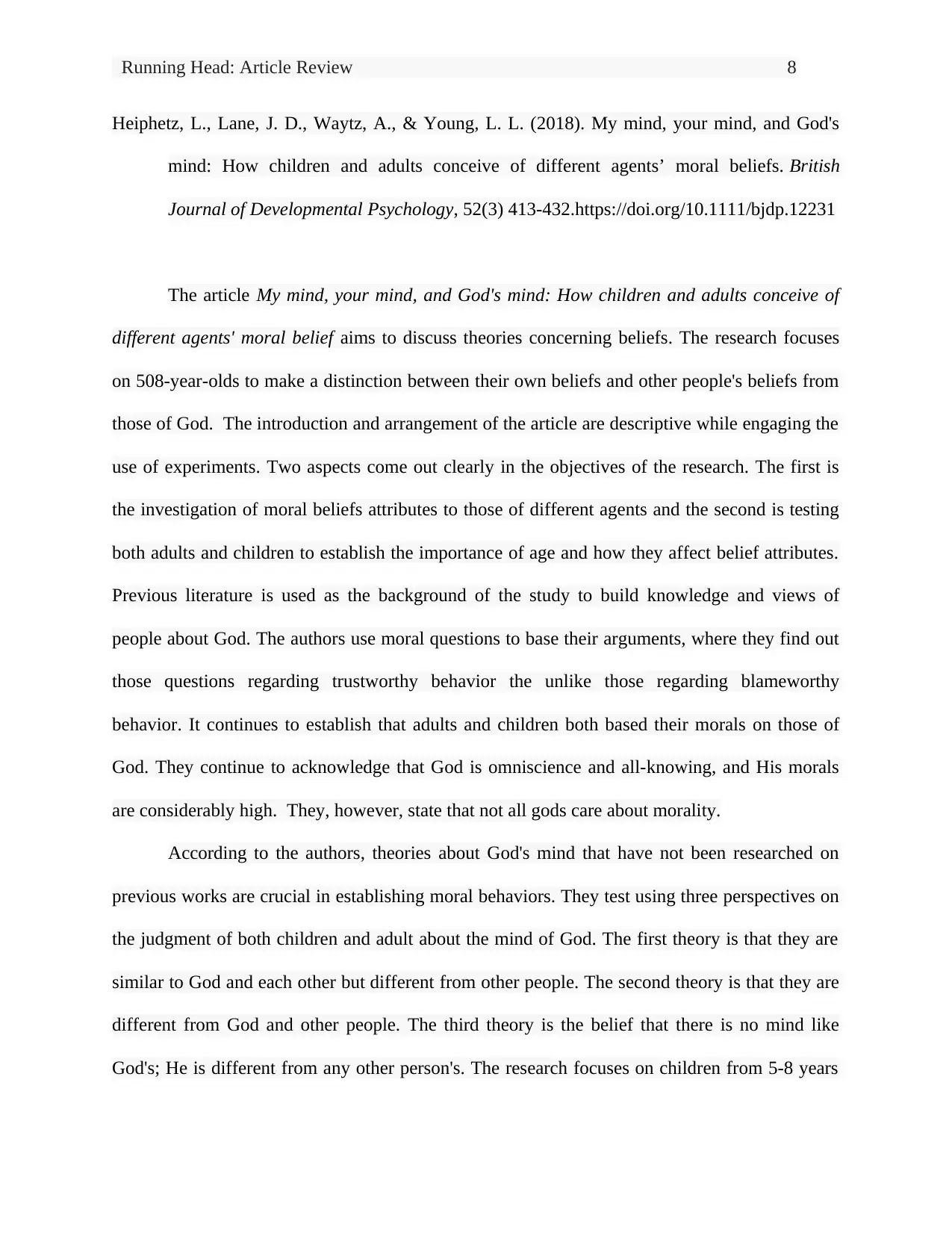
Running Head: Article Review 8
Heiphetz, L., Lane, J. D., Waytz, A., & Young, L. L. (2018). My mind, your mind, and God's
mind: How children and adults conceive of different agents’ moral beliefs. British
Journal of Developmental Psychology, 52(3) 413-432.https://doi.org/10.1111/bjdp.12231
The article My mind, your mind, and God's mind: How children and adults conceive of
different agents' moral belief aims to discuss theories concerning beliefs. The research focuses
on 508-year-olds to make a distinction between their own beliefs and other people's beliefs from
those of God. The introduction and arrangement of the article are descriptive while engaging the
use of experiments. Two aspects come out clearly in the objectives of the research. The first is
the investigation of moral beliefs attributes to those of different agents and the second is testing
both adults and children to establish the importance of age and how they affect belief attributes.
Previous literature is used as the background of the study to build knowledge and views of
people about God. The authors use moral questions to base their arguments, where they find out
those questions regarding trustworthy behavior the unlike those regarding blameworthy
behavior. It continues to establish that adults and children both based their morals on those of
God. They continue to acknowledge that God is omniscience and all-knowing, and His morals
are considerably high. They, however, state that not all gods care about morality.
According to the authors, theories about God's mind that have not been researched on
previous works are crucial in establishing moral behaviors. They test using three perspectives on
the judgment of both children and adult about the mind of God. The first theory is that they are
similar to God and each other but different from other people. The second theory is that they are
different from God and other people. The third theory is the belief that there is no mind like
God's; He is different from any other person's. The research focuses on children from 5-8 years
Heiphetz, L., Lane, J. D., Waytz, A., & Young, L. L. (2018). My mind, your mind, and God's
mind: How children and adults conceive of different agents’ moral beliefs. British
Journal of Developmental Psychology, 52(3) 413-432.https://doi.org/10.1111/bjdp.12231
The article My mind, your mind, and God's mind: How children and adults conceive of
different agents' moral belief aims to discuss theories concerning beliefs. The research focuses
on 508-year-olds to make a distinction between their own beliefs and other people's beliefs from
those of God. The introduction and arrangement of the article are descriptive while engaging the
use of experiments. Two aspects come out clearly in the objectives of the research. The first is
the investigation of moral beliefs attributes to those of different agents and the second is testing
both adults and children to establish the importance of age and how they affect belief attributes.
Previous literature is used as the background of the study to build knowledge and views of
people about God. The authors use moral questions to base their arguments, where they find out
those questions regarding trustworthy behavior the unlike those regarding blameworthy
behavior. It continues to establish that adults and children both based their morals on those of
God. They continue to acknowledge that God is omniscience and all-knowing, and His morals
are considerably high. They, however, state that not all gods care about morality.
According to the authors, theories about God's mind that have not been researched on
previous works are crucial in establishing moral behaviors. They test using three perspectives on
the judgment of both children and adult about the mind of God. The first theory is that they are
similar to God and each other but different from other people. The second theory is that they are
different from God and other people. The third theory is the belief that there is no mind like
God's; He is different from any other person's. The research focuses on children from 5-8 years
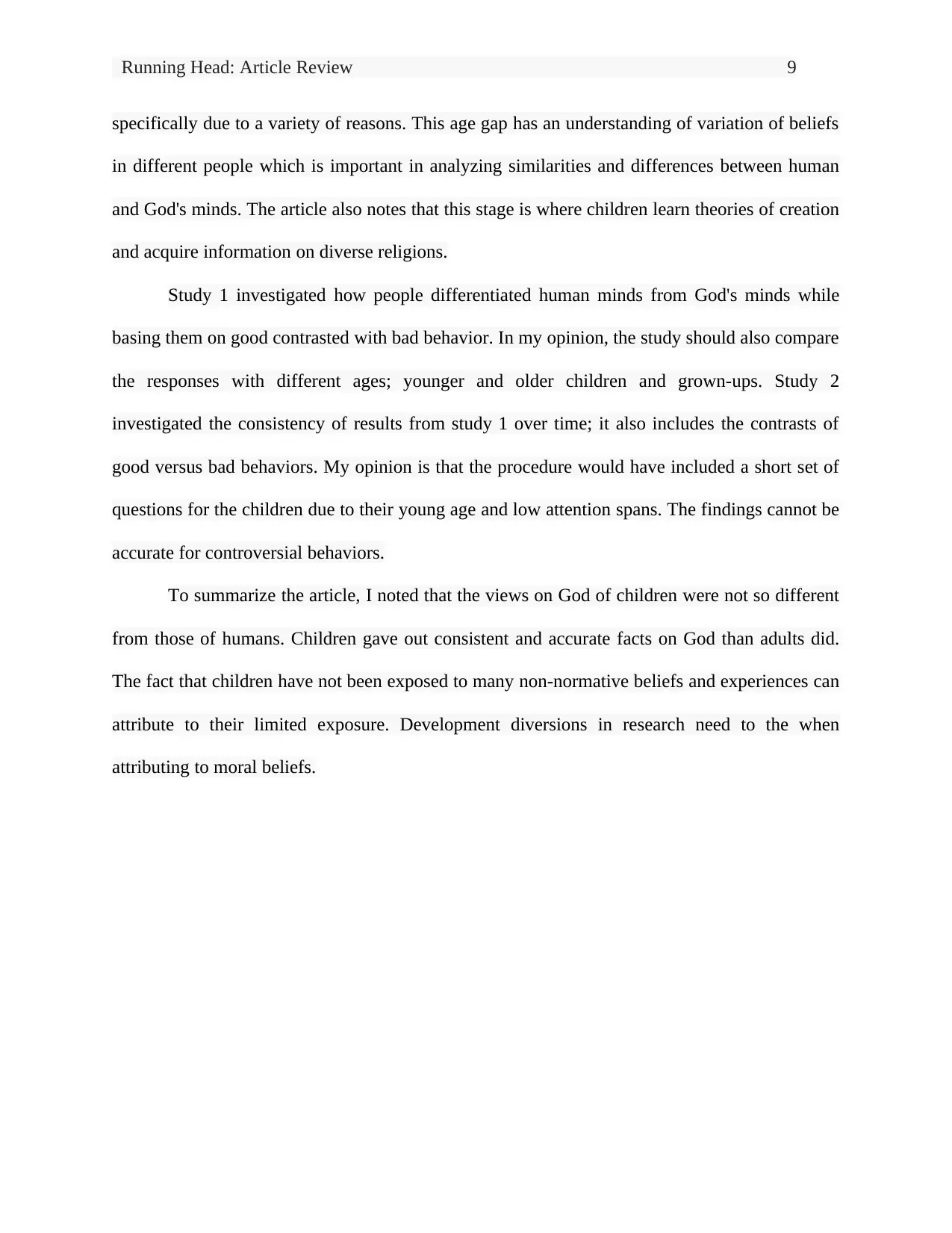
Running Head: Article Review 9
specifically due to a variety of reasons. This age gap has an understanding of variation of beliefs
in different people which is important in analyzing similarities and differences between human
and God's minds. The article also notes that this stage is where children learn theories of creation
and acquire information on diverse religions.
Study 1 investigated how people differentiated human minds from God's minds while
basing them on good contrasted with bad behavior. In my opinion, the study should also compare
the responses with different ages; younger and older children and grown-ups. Study 2
investigated the consistency of results from study 1 over time; it also includes the contrasts of
good versus bad behaviors. My opinion is that the procedure would have included a short set of
questions for the children due to their young age and low attention spans. The findings cannot be
accurate for controversial behaviors.
To summarize the article, I noted that the views on God of children were not so different
from those of humans. Children gave out consistent and accurate facts on God than adults did.
The fact that children have not been exposed to many non-normative beliefs and experiences can
attribute to their limited exposure. Development diversions in research need to the when
attributing to moral beliefs.
specifically due to a variety of reasons. This age gap has an understanding of variation of beliefs
in different people which is important in analyzing similarities and differences between human
and God's minds. The article also notes that this stage is where children learn theories of creation
and acquire information on diverse religions.
Study 1 investigated how people differentiated human minds from God's minds while
basing them on good contrasted with bad behavior. In my opinion, the study should also compare
the responses with different ages; younger and older children and grown-ups. Study 2
investigated the consistency of results from study 1 over time; it also includes the contrasts of
good versus bad behaviors. My opinion is that the procedure would have included a short set of
questions for the children due to their young age and low attention spans. The findings cannot be
accurate for controversial behaviors.
To summarize the article, I noted that the views on God of children were not so different
from those of humans. Children gave out consistent and accurate facts on God than adults did.
The fact that children have not been exposed to many non-normative beliefs and experiences can
attribute to their limited exposure. Development diversions in research need to the when
attributing to moral beliefs.
⊘ This is a preview!⊘
Do you want full access?
Subscribe today to unlock all pages.

Trusted by 1+ million students worldwide
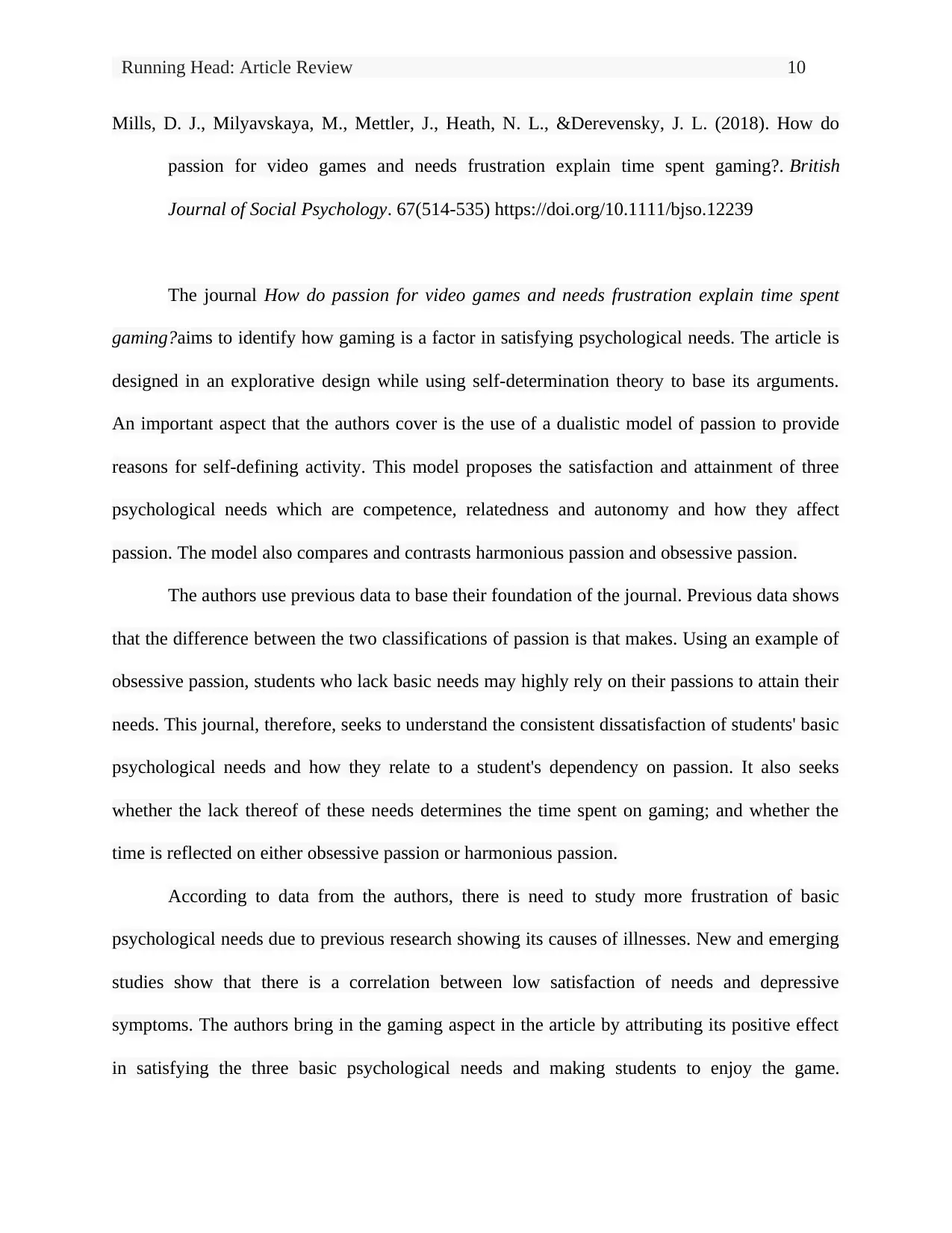
Running Head: Article Review 10
Mills, D. J., Milyavskaya, M., Mettler, J., Heath, N. L., &Derevensky, J. L. (2018). How do
passion for video games and needs frustration explain time spent gaming?. British
Journal of Social Psychology. 67(514-535) https://doi.org/10.1111/bjso.12239
The journal How do passion for video games and needs frustration explain time spent
gaming?aims to identify how gaming is a factor in satisfying psychological needs. The article is
designed in an explorative design while using self-determination theory to base its arguments.
An important aspect that the authors cover is the use of a dualistic model of passion to provide
reasons for self-defining activity. This model proposes the satisfaction and attainment of three
psychological needs which are competence, relatedness and autonomy and how they affect
passion. The model also compares and contrasts harmonious passion and obsessive passion.
The authors use previous data to base their foundation of the journal. Previous data shows
that the difference between the two classifications of passion is that makes. Using an example of
obsessive passion, students who lack basic needs may highly rely on their passions to attain their
needs. This journal, therefore, seeks to understand the consistent dissatisfaction of students' basic
psychological needs and how they relate to a student's dependency on passion. It also seeks
whether the lack thereof of these needs determines the time spent on gaming; and whether the
time is reflected on either obsessive passion or harmonious passion.
According to data from the authors, there is need to study more frustration of basic
psychological needs due to previous research showing its causes of illnesses. New and emerging
studies show that there is a correlation between low satisfaction of needs and depressive
symptoms. The authors bring in the gaming aspect in the article by attributing its positive effect
in satisfying the three basic psychological needs and making students to enjoy the game.
Mills, D. J., Milyavskaya, M., Mettler, J., Heath, N. L., &Derevensky, J. L. (2018). How do
passion for video games and needs frustration explain time spent gaming?. British
Journal of Social Psychology. 67(514-535) https://doi.org/10.1111/bjso.12239
The journal How do passion for video games and needs frustration explain time spent
gaming?aims to identify how gaming is a factor in satisfying psychological needs. The article is
designed in an explorative design while using self-determination theory to base its arguments.
An important aspect that the authors cover is the use of a dualistic model of passion to provide
reasons for self-defining activity. This model proposes the satisfaction and attainment of three
psychological needs which are competence, relatedness and autonomy and how they affect
passion. The model also compares and contrasts harmonious passion and obsessive passion.
The authors use previous data to base their foundation of the journal. Previous data shows
that the difference between the two classifications of passion is that makes. Using an example of
obsessive passion, students who lack basic needs may highly rely on their passions to attain their
needs. This journal, therefore, seeks to understand the consistent dissatisfaction of students' basic
psychological needs and how they relate to a student's dependency on passion. It also seeks
whether the lack thereof of these needs determines the time spent on gaming; and whether the
time is reflected on either obsessive passion or harmonious passion.
According to data from the authors, there is need to study more frustration of basic
psychological needs due to previous research showing its causes of illnesses. New and emerging
studies show that there is a correlation between low satisfaction of needs and depressive
symptoms. The authors bring in the gaming aspect in the article by attributing its positive effect
in satisfying the three basic psychological needs and making students to enjoy the game.
Paraphrase This Document
Need a fresh take? Get an instant paraphrase of this document with our AI Paraphraser
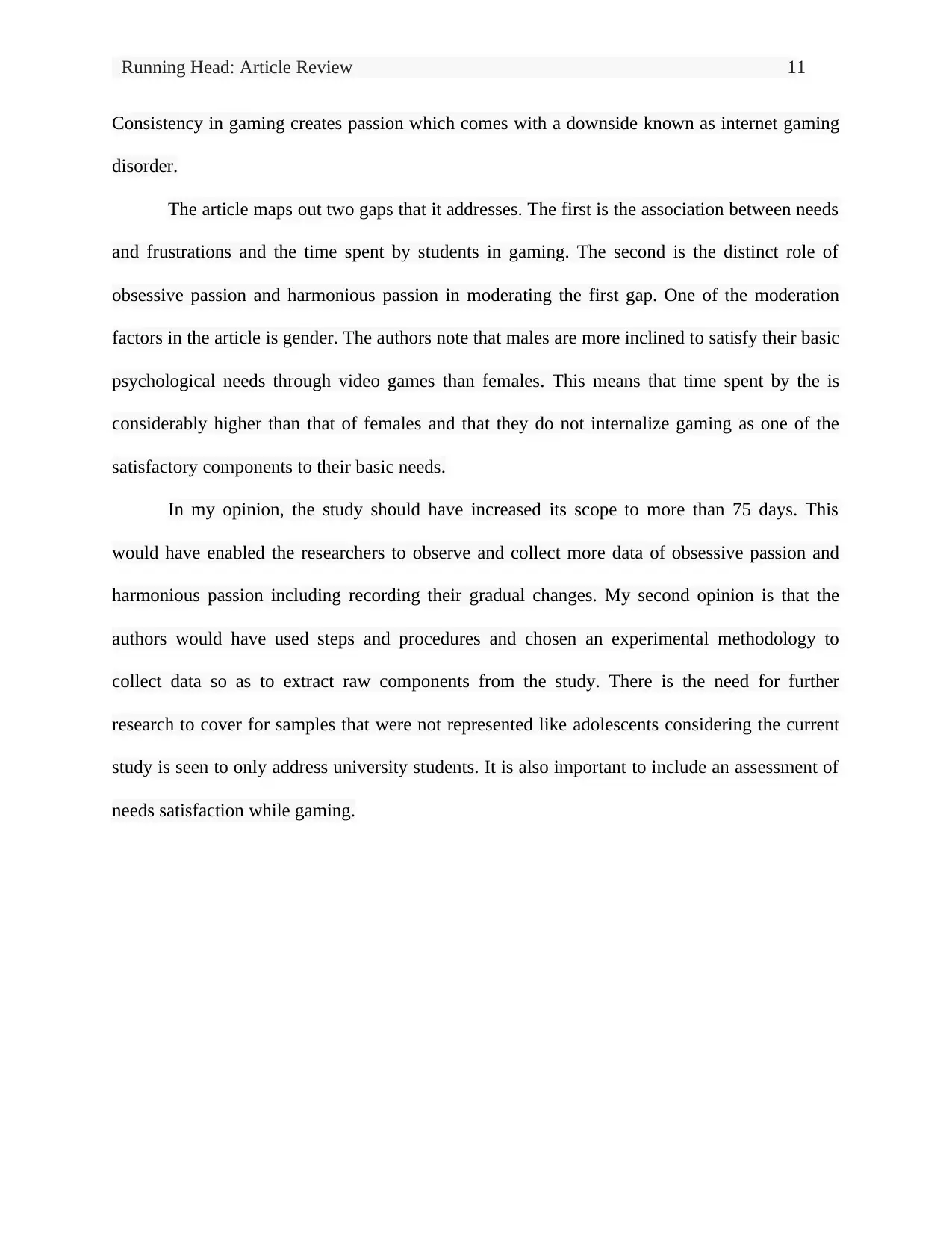
Running Head: Article Review 11
Consistency in gaming creates passion which comes with a downside known as internet gaming
disorder.
The article maps out two gaps that it addresses. The first is the association between needs
and frustrations and the time spent by students in gaming. The second is the distinct role of
obsessive passion and harmonious passion in moderating the first gap. One of the moderation
factors in the article is gender. The authors note that males are more inclined to satisfy their basic
psychological needs through video games than females. This means that time spent by the is
considerably higher than that of females and that they do not internalize gaming as one of the
satisfactory components to their basic needs.
In my opinion, the study should have increased its scope to more than 75 days. This
would have enabled the researchers to observe and collect more data of obsessive passion and
harmonious passion including recording their gradual changes. My second opinion is that the
authors would have used steps and procedures and chosen an experimental methodology to
collect data so as to extract raw components from the study. There is the need for further
research to cover for samples that were not represented like adolescents considering the current
study is seen to only address university students. It is also important to include an assessment of
needs satisfaction while gaming.
Consistency in gaming creates passion which comes with a downside known as internet gaming
disorder.
The article maps out two gaps that it addresses. The first is the association between needs
and frustrations and the time spent by students in gaming. The second is the distinct role of
obsessive passion and harmonious passion in moderating the first gap. One of the moderation
factors in the article is gender. The authors note that males are more inclined to satisfy their basic
psychological needs through video games than females. This means that time spent by the is
considerably higher than that of females and that they do not internalize gaming as one of the
satisfactory components to their basic needs.
In my opinion, the study should have increased its scope to more than 75 days. This
would have enabled the researchers to observe and collect more data of obsessive passion and
harmonious passion including recording their gradual changes. My second opinion is that the
authors would have used steps and procedures and chosen an experimental methodology to
collect data so as to extract raw components from the study. There is the need for further
research to cover for samples that were not represented like adolescents considering the current
study is seen to only address university students. It is also important to include an assessment of
needs satisfaction while gaming.
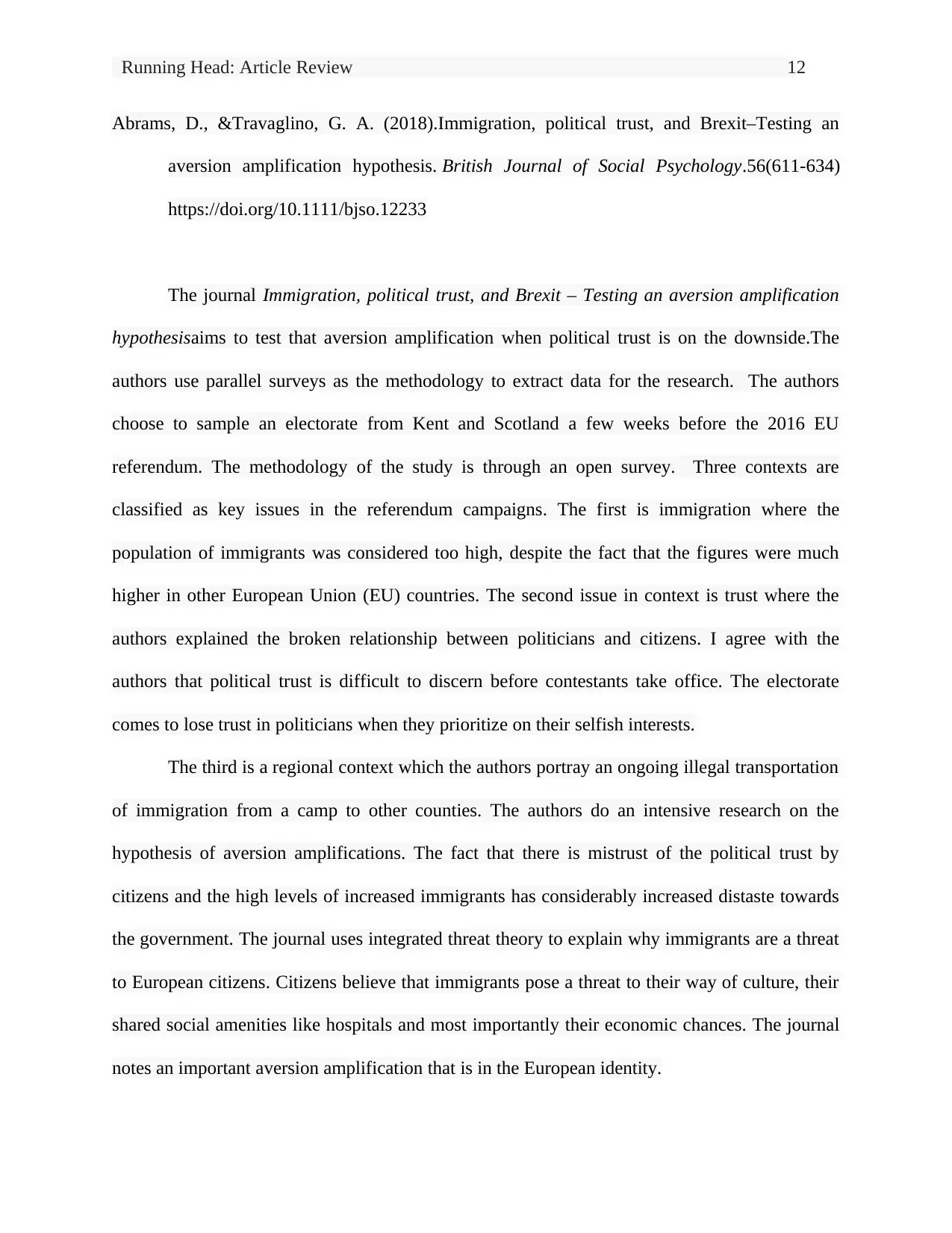
Running Head: Article Review 12
Abrams, D., &Travaglino, G. A. (2018).Immigration, political trust, and Brexit–Testing an
aversion amplification hypothesis. British Journal of Social Psychology.56(611-634)
https://doi.org/10.1111/bjso.12233
The journal Immigration, political trust, and Brexit – Testing an aversion amplification
hypothesisaims to test that aversion amplification when political trust is on the downside.The
authors use parallel surveys as the methodology to extract data for the research. The authors
choose to sample an electorate from Kent and Scotland a few weeks before the 2016 EU
referendum. The methodology of the study is through an open survey. Three contexts are
classified as key issues in the referendum campaigns. The first is immigration where the
population of immigrants was considered too high, despite the fact that the figures were much
higher in other European Union (EU) countries. The second issue in context is trust where the
authors explained the broken relationship between politicians and citizens. I agree with the
authors that political trust is difficult to discern before contestants take office. The electorate
comes to lose trust in politicians when they prioritize on their selfish interests.
The third is a regional context which the authors portray an ongoing illegal transportation
of immigration from a camp to other counties. The authors do an intensive research on the
hypothesis of aversion amplifications. The fact that there is mistrust of the political trust by
citizens and the high levels of increased immigrants has considerably increased distaste towards
the government. The journal uses integrated threat theory to explain why immigrants are a threat
to European citizens. Citizens believe that immigrants pose a threat to their way of culture, their
shared social amenities like hospitals and most importantly their economic chances. The journal
notes an important aversion amplification that is in the European identity.
Abrams, D., &Travaglino, G. A. (2018).Immigration, political trust, and Brexit–Testing an
aversion amplification hypothesis. British Journal of Social Psychology.56(611-634)
https://doi.org/10.1111/bjso.12233
The journal Immigration, political trust, and Brexit – Testing an aversion amplification
hypothesisaims to test that aversion amplification when political trust is on the downside.The
authors use parallel surveys as the methodology to extract data for the research. The authors
choose to sample an electorate from Kent and Scotland a few weeks before the 2016 EU
referendum. The methodology of the study is through an open survey. Three contexts are
classified as key issues in the referendum campaigns. The first is immigration where the
population of immigrants was considered too high, despite the fact that the figures were much
higher in other European Union (EU) countries. The second issue in context is trust where the
authors explained the broken relationship between politicians and citizens. I agree with the
authors that political trust is difficult to discern before contestants take office. The electorate
comes to lose trust in politicians when they prioritize on their selfish interests.
The third is a regional context which the authors portray an ongoing illegal transportation
of immigration from a camp to other counties. The authors do an intensive research on the
hypothesis of aversion amplifications. The fact that there is mistrust of the political trust by
citizens and the high levels of increased immigrants has considerably increased distaste towards
the government. The journal uses integrated threat theory to explain why immigrants are a threat
to European citizens. Citizens believe that immigrants pose a threat to their way of culture, their
shared social amenities like hospitals and most importantly their economic chances. The journal
notes an important aversion amplification that is in the European identity.
⊘ This is a preview!⊘
Do you want full access?
Subscribe today to unlock all pages.

Trusted by 1+ million students worldwide
1 out of 21
Related Documents
Your All-in-One AI-Powered Toolkit for Academic Success.
+13062052269
info@desklib.com
Available 24*7 on WhatsApp / Email
![[object Object]](/_next/static/media/star-bottom.7253800d.svg)
Unlock your academic potential
Copyright © 2020–2025 A2Z Services. All Rights Reserved. Developed and managed by ZUCOL.





